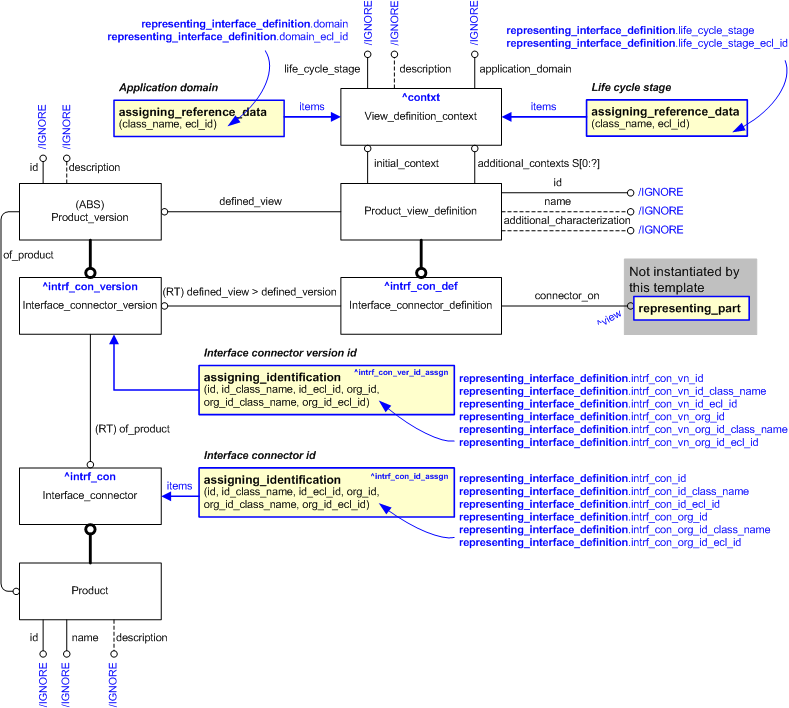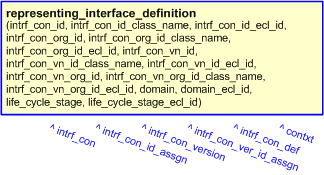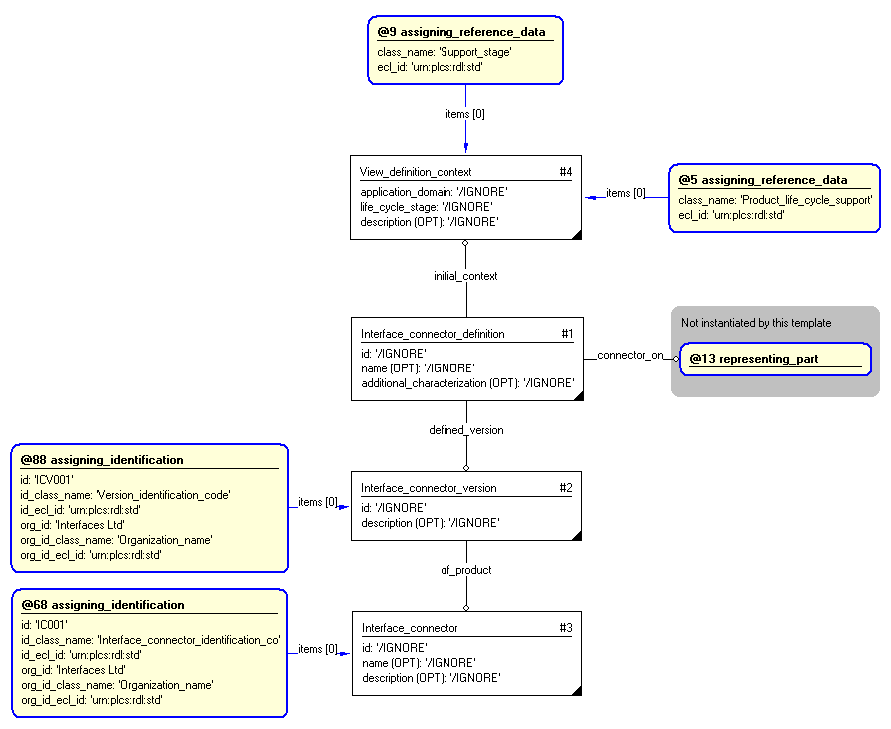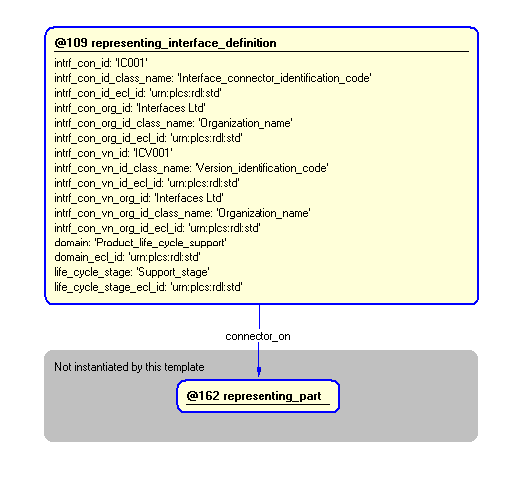Template:— representing_interface_definition (rep_interf_def)
Capability:representing_parts |
Date: 2011/10/07 08:40:47
Revision: 1.1
|
![[warning:]](../../../../images/dex/warning.gif) Error T1: There is no template_proxy in the capability representing_parts for the template representing_interface_definition
Error T1: There is no template_proxy in the capability representing_parts for the template representing_interface_definition
This section specifies the template representing_interface_definition.
NOTE
The template has been defined in the context of the capability
representing_parts
which provides an overall description of the
relevant parts of the ISO 10303-239 information model and a description
of related templates.
NOTE
An explanation of a template and the associated instantiation path is
provided in the
Template overview
section.
This template describes how to represent an inteface definition.
EXAMPLE
The specification of an interface between pipes where those pipes connect.
The EXPRESS-G diagram in
Figure
1
shows the templates and EXPRESS entities that are required
to represent the template
"representing_interface_definition".
The text highlighted in blue shows the template parameters.
Figure 1 — An EXPRESS-G representation of the Information model for
representing_interface_definition
The graphic for the template to be used in other EXPRESS-G diagrams
is shown in Figure
2
below.
Figure 2 — The graphical representation of the representing_interface_definition
template
The following input parameters are defined for this template:
The identifier of the interface connector.
The name of the class used to classify the identifier assigned (using
Identification_assignment ) to the interface connector.
The following classes and their sub-classes can be used:
The name or identifier of the organization that is responsible for the
identifier of the interface connector.
The name of the class used to classify the identifier of the organization that is
responsible for the identifier of the interface connector.
The following classes and their sub-classes can be used:
The identifier of the
External_class_library that holds the
definition of the
External_class used to classify the
identifier of the organization that is responsible for the identifier of the interface
connector.
The identifier of the interface connector version.
The name of the class used to classify the identifier assigned (
Identification_assignment ) to the interface connector version.
The following classes and their sub-classes can be used:
The name or identifier of the organization responsible for the identifier
assigned to the interface connector version.
The name of the class used to classify the identifier (
Identification_assignment) of the organization responsible for the identifier assigned to the interface connector
version.
The following classes and their sub-classes can be used:
The identifier of the
External_class_library that holds the
definition of the
External_class used to classify the
identifier of the organization responsible for the identifier assigned to the interface
connector version.
domain (Default=Product_life_cycle_support,Type='CLASS', Optional)
The name of the class used to describe the application domain of the
View_definition_context for the interface connector definition.
The following classes and their sub-classes can be used:
The name of the class used to describe the life cycle stage of the
View_definition_context for the interface connector definition.
The following classes and their sub-classes can be used:
The part that has an interface connection.
The following reference parameters are defined for this template:
Allow the
Interface_connector
entity instantiated in this path to be referenced when this template is used.
%^target = $representing_interface_definition.intrf_con%
%^target = $representing_interface_definition.intrf_con_id_assgn%
%^target = $representing_interface_definition.intrf_con_version%
%^target = $representing_interface_definition.intrf_con_ver_id_assgn%
%^target = $representing_interface_definition.intrf_con_def%
%^target = $representing_interface_definition.contxt%
The following parameter combinations specify a uniqueness constraint:
Unique constraint: Unique interface_connector
Unique constraint: Unique interface_connector_definition
Each instance of the
entity
(
Interface_connector_definition)
within the data set shall be uniquely identified
by a combination of the following parameters on this
template (representing_interface_definition) namely:
intrf_con_id,
intrf_con_id_class_name,
intrf_con_id_ecl_id,
intrf_con_org_id,
intrf_con_org_id_class_name,
intrf_con_org_id_ecl_id,
intrf_con_vn_id,
intrf_con_vn_id_class_name,
intrf_con_vn_id_ecl_id,
intrf_con_vn_org_id,
intrf_con_vn_org_id_class_name,
intrf_con_vn_org_id_ecl_id,
domain,
domain_ecl_id,
life_cycle_stage,
life_cycle_stage_ecl_id.
The
instance is
referenced by the following template parameter:
intrf_con_def.
Unique constraint: Unique interface_connector_version
Each instance of the
entity
(
Interface_connector_version)
within the data set shall be uniquely identified
by a combination of the following parameters on this
template (representing_interface_definition) namely:
intrf_con_id,
intrf_con_id_class_name,
intrf_con_id_ecl_id,
intrf_con_org_id,
intrf_con_org_id_class_name,
intrf_con_org_id_ecl_id,
intrf_con_vn_id,
intrf_con_vn_id_class_name,
intrf_con_vn_id_ecl_id,
intrf_con_vn_org_id,
intrf_con_vn_org_id_class_name,
intrf_con_vn_org_id_ecl_id.
The
instance is
referenced by the following template parameter:
intrf_con_version.
Unique constraint: Unique view_definition_context
The instantiation path shown below specifies the entities that are to be
instantiated by the template.
A description of templates and the syntax for the instantiation path is
provided in the
Templates Help/Information section.
-- Interface_connector Interface_connector%^intrf_con =
Interface_connector%
Interface_connector.id = '/IGNORE'
Interface_connector.name = '/IGNORE'
Interface_connector.description = '/IGNORE'
-- Identify the Interface_connector /
assigning_identification(
items=^intrf_con,
id=@intrf_con_id,
id_class_name=@intrf_con_id_class_name,
id_ecl_id=@intrf_con_id_ecl_id,
org_id=@intrf_con_org_id,
org_id_class_name=@intrf_con_org_id_class_name,
org_id_ecl_id=@intrf_con_org_id_ecl_id )/
-- Ref parameter for the Interface_connector indentification %^intrf_con_id_assgn = $assigning_identification.id_assgn%
-- Interface_connector_version Interface_connector_version%^intrf_con_version =
Interface_connector_version%
Interface_connector_version.id = '/IGNORE'
Interface_connector_version.description = '/IGNORE'
Interface_connector_version.of_product ->
Interface_connector-- Identify the Interface_connector_version /
assigning_identification(
items=^intrf_con_version,
id=@intrf_con_vn_id,
id_class_name=@intrf_con_vn_id_class_name,
id_ecl_id=@intrf_con_vn_id_ecl_id,
org_id=@intrf_con_vn_org_id,
org_id_class_name=@intrf_con_vn_org_id_class_name,
org_id_ecl_id=@intrf_con_vn_org_id_ecl_id )/
-- Ref parameter for the Interface_connector_version indentification %^intrf_con_ver_id_assgn = $assigning_identification.id_assgn%
View_definition_context%^contxt =
View_definition_context%
View_definition_context.application_domain = '/IGNORE'
View_definition_context.life_cycle_stage = '/IGNORE'
View_definition_context.description = '/IGNORE'
-- Application domain of the view definition /
assigning_reference_data(
items=^contxt,
class_name=@domain,
ecl_id=@domain_ecl_id )/
-- Life cycle stage of the view definition /
assigning_reference_data(
items=^contxt,
class_name=@life_cycle_stage,
ecl_id=@life_cycle_stage_ecl_id )/
-- Interface_connector_definition Interface_connector_definition%^intrf_con_def =
Interface_connector_definition%
Interface_connector_definition.id = '/IGNORE'
Interface_connector_definition.name = '/IGNORE'
Interface_connector_definition.additional_characterization = '/IGNORE'
Interface_connector_definition.defined_version ->
Interface_connector_versionInterface_connector_definition.initial_context ->
View_definition_contextInterface_connector_definition.connector_on ->
@connector_on
The following entities are instantiated with attributes as specified:
The instance diagram in Figure
3
shows an example of the EXPRESS entities and templates that are instantiated by the template:
/representing_interface_definition(intrf_con_id='IC001', intrf_con_id_class_name='Interface_connector_identification_code', intrf_con_id_ecl_id='urn:plcs:rdl:std', intrf_con_org_id='Interfaces Ltd', intrf_con_org_id_class_name='Organization_name', intrf_con_org_id_ecl_id='urn:plcs:rdl:std', intrf_con_vn_id='ICV001', intrf_con_vn_id_class_name='Version_identification_code', intrf_con_vn_id_ecl_id='urn:plcs:rdl:std', intrf_con_vn_org_id='Interfaces Ltd', intrf_con_vn_org_id_class_name='Organization_name', intrf_con_vn_org_id_ecl_id='urn:plcs:rdl:std', domain='Product_life_cycle_support', domain_ecl_id='urn:plcs:rdl:std', life_cycle_stage='Support_stage', life_cycle_stage_ecl_id='urn:plcs:rdl:std', connector_on='@162')/
(an illustration of the consolidated representing_interface_definition template is shown in
Figure
4 below.)
Figure 3 — Entities instantiated by representing_interface_definition template
The instance diagram in
Figure
4
shows the graphic symbol for the template that is to be
used in other instance diagrams. The example template is:
/representing_interface_definition(intrf_con_id='IC001', intrf_con_id_class_name='Interface_connector_identification_code', intrf_con_id_ecl_id='urn:plcs:rdl:std', intrf_con_org_id='Interfaces Ltd', intrf_con_org_id_class_name='Organization_name', intrf_con_org_id_ecl_id='urn:plcs:rdl:std', intrf_con_vn_id='ICV001', intrf_con_vn_id_class_name='Version_identification_code', intrf_con_vn_id_ecl_id='urn:plcs:rdl:std', intrf_con_vn_org_id='Interfaces Ltd', intrf_con_vn_org_id_class_name='Organization_name', intrf_con_vn_org_id_ecl_id='urn:plcs:rdl:std', domain='Product_life_cycle_support', domain_ecl_id='urn:plcs:rdl:std', life_cycle_stage='Support_stage', life_cycle_stage_ecl_id='urn:plcs:rdl:std', connector_on='@162')/
Figure 4 — Instantiation of representing_interface_definition template
Characterizations
No common characterizations of the template
representing_interface_definition
have been identified. However, the ISO 10303-239 EXPRESS model
may enable other assignments to the entities instantiated by the template.




